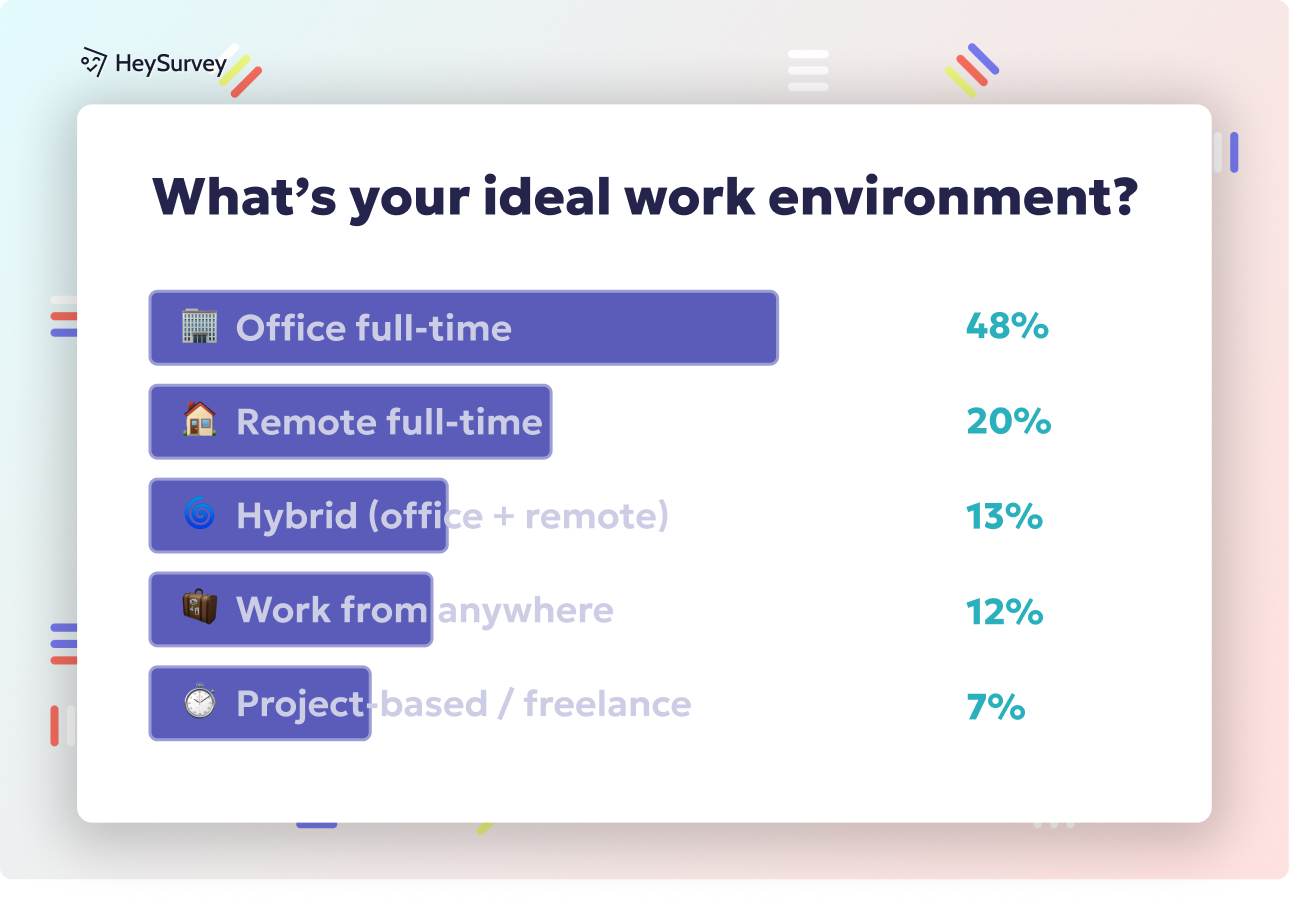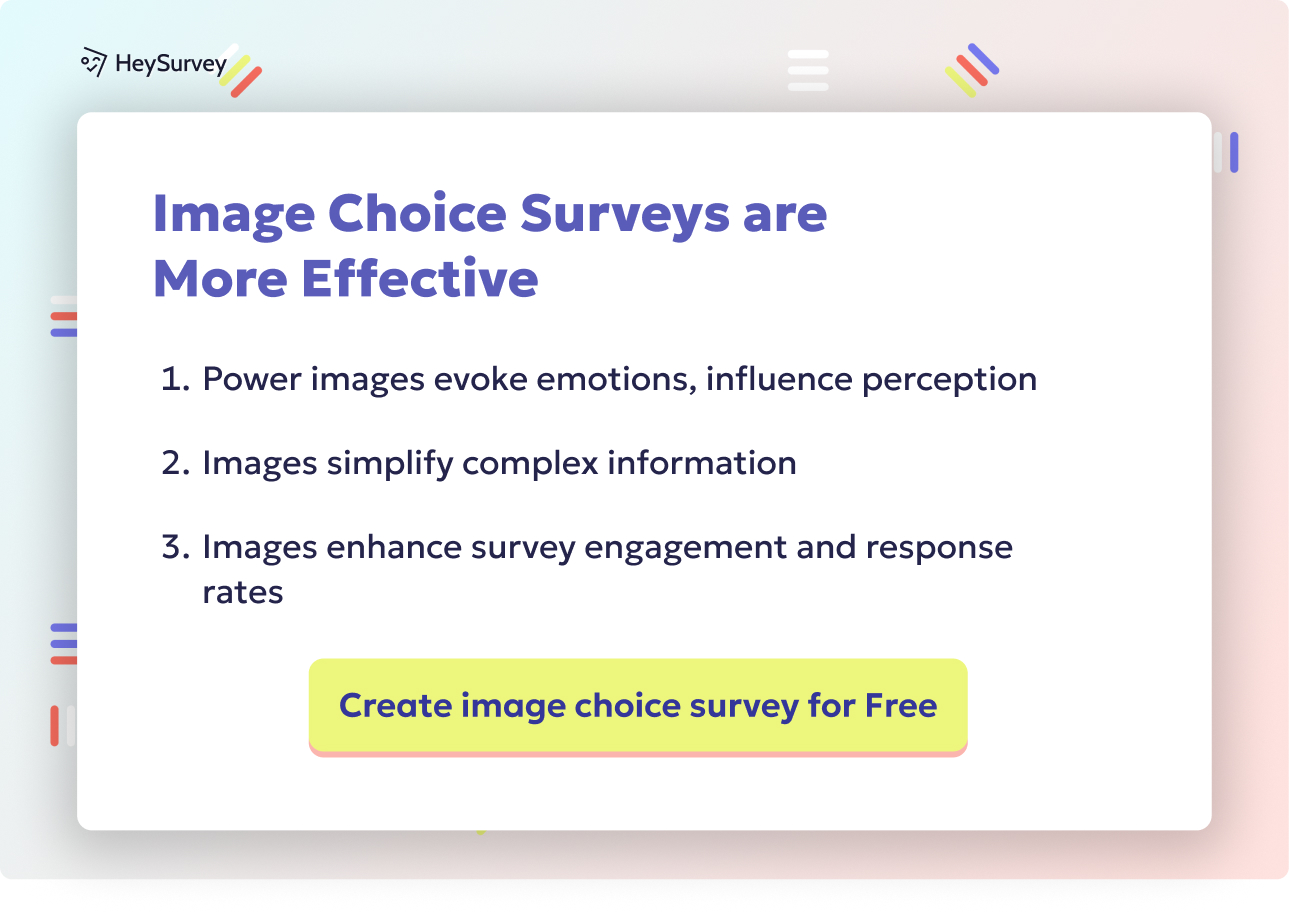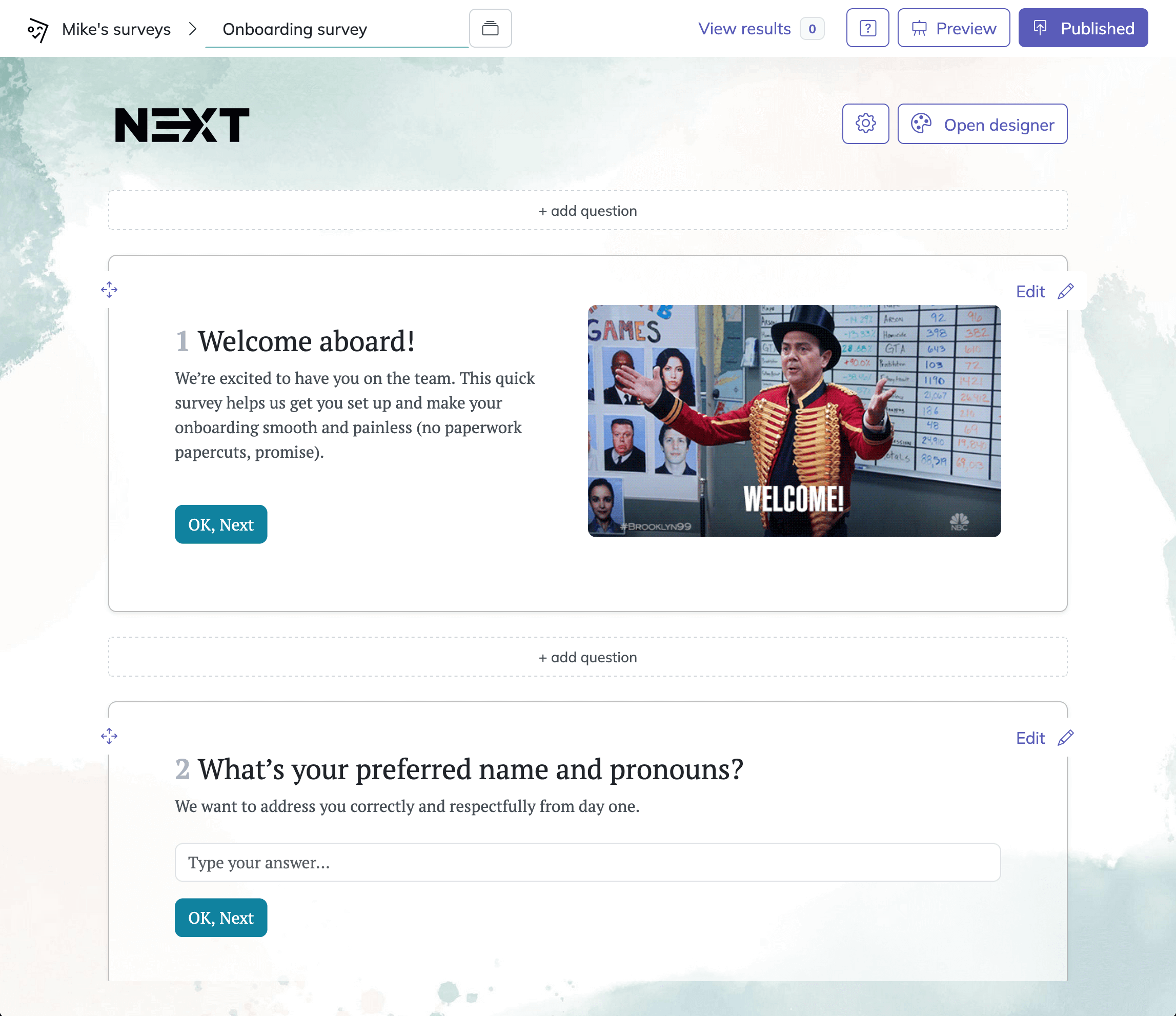31 Mutually Exclusive Survey Questions: A Quick Guide
Master the art of mutually exclusive survey questions with 25 sample questions. Explore best practices to perfect your data collection.
Mutually exclusive survey questions help you gather better data by ensuring each response is unique. They eliminate confusion, simplifying the respondent’s experience and guiding them toward clear, single-choice answers. They make data analysis simpler, ensuring that you can draw stronger conclusions faster.
Key Advantages of Mutually Exclusive Questions
Accurate and structured data is a big plus when your survey format only allows for one answer in each case. This ensures respondents know exactly how to answer, and you can trust that one choice reflects their true position, without overlap. It’s a straightforward approach that pays off in both short and long surveys.
According to a new marketing survey from SurveyMonkey, 72% of participants said they were more likely to complete a survey with distinct answer options. Source
Improved Data Accuracy
Focused response inputs mean you won’t end up with contradictory selections in the same question. By having only one possible valid choice, your dataset becomes more uniform, which makes it easier to analyze trends. When results are free of overlaps, each piece of feedback contributes to a crystal-clear understanding of how people feel or behave.
Enhanced Respondent Experience
Simplicity in question design reduces guesswork for the participant. When they see a neatly structured set of choices, they immediately recognize that only one applies. This leads to quick decision-making, leaving the survey-taker with a positive impression that often boosts completion rates.
More Meaningful Analysis
Streamlined data analysis is what you get once your respondents answer in a mutually exclusive manner. Because you avoid overlapping categories, it becomes simple to compare groups or segments of your audience. The neat separation of responses adds clarity, making it easier to spot patterns and develop actionable strategies.

Single-Choice Radio Button Surveys
Radio button queries provide a list of choices, but only one can be selected. They often appear as small circles beside each option, and respondents simply click the circle that best matches their stance. This style is fantastic when you want quick answers to everyday questions or demographic prompts.
Why and When to Use This Type
Direct categorical identification is ideal when dealing with short, specific questions like “Which device do you use most often?” Radio buttons excel in scenarios where you want participants to pick the single best option from a concise list of options. This keeps your data neatly arranged and helps you quickly pinpoint preferences or trends.
Five Sample Questions
- What is your preferred mode of transportation?
- Which of the following meal types do you usually have for lunch?
- Which best describes your current employment status?
- Which mobile operating system do you use most frequently?
- What is your highest level of educational attainment?
Create your survey, it's 100% free
Step 1: Create a New Survey
Click the “Open Template” button below these instructions, or choose an empty sheet if you prefer starting from scratch. After you select your starting point, the Survey Editor will appear. Here, you can give your survey an internal name and begin shaping it for your mutually exclusive questions.
Step 2: Add Your Questions
Inside the Survey Editor, select “Add Question.” Choose single-choice or radio button question types to ensure that respondents can pick only one option. Adjust any labels, images, or markdown formatting for clarity. Mark crucial questions as required so participants must provide a response before moving on.
Step 3: Publish Your Survey
Once you’re satisfied, click “Publish.” You’ll need a HeySurvey account for publishing and collecting results. On publishing, you’ll get a shareable link that you can distribute or embed on your site. Responses will be recorded in real time, and you can watch them roll in from your dashboard.
Bonus Steps
• Apply Branding: Upload your own logo in the Branding panel so your survey feels fully yours.
• Define Settings: Configure start and end dates, set response limits, or specify a redirect URL for when respondents finish.
• Skip into Branches: If you want personalized follow-up questions, use branching. You can send respondents to different question sets based on their answers, creating a tailored survey journey.
Dichotomous (Yes/No) Surveys
Yes/No queries are straightforward and satisfy the need for quick binary opinions. They work well when there’s a clear line, such as a basic agreement, an eligibility requirement, or a verification of a fact. This format is also beneficial for decreasing question complexity.
A study from Pollfish found that surveys with a Yes/No format see a 15% higher completion rate than those with more complex structures. Source
Why and When to Use This Type
Swift fact-checking is a strong point of this survey format, which makes it great for screening or qualification questions. If you only need to know whether someone has purchased your product before, or you want to confirm their age bracket, a Yes/No framework is simple and effective. It fosters minimal confusion, ensuring your insights remain credible.
Five Sample Questions
- Have you purchased any of our products before?
- Do you currently own a car?
- Are you over 18 years of age?
- Do you agree to the terms and conditions?
- Are you currently employed full-time?
True/False Surveys
Quick validation surveys apply the True/False style for assessing whether participants believe a statement is accurate. It’s especially helpful in quizzes, knowledge checks, or gauging general perceptions on certain facts. With only two possible answers, you get to the heart of an issue without confusion.
Why and When to Use This Type
Instant knowledge checks serve industries like education, compliance, or internal audits. If your organization needs to confirm awareness of certain policies or wants to test how well guidelines are understood, True/False questions fit the bill. This format also helps measure whether a particular piece of information resonates with your audience.
Five Sample Questions
- True or False: Our new product launched last quarter.
- True or False: The company’s head office is located in New York.
- True or False: Turning off notifications helps reduce screen time.
- True or False: This course requires a master’s degree for enrollment.
- True or False: All employees must attend the weekly staff meeting.

Drop-Down Single-Select Surveys
Dropdown menus tidy up your survey when you have a large array of options. Instead of bombarding respondents with numerous lines of radio buttons, you group them into one dropdown list. That approach keeps the page looking clean and helps participants find their exact choice.
Why and When to Use This Type
Organized answer repositories work well if you’re dealing with extensive lists like countries, job roles, or languages. A single-select dropdown ensures that only one response fits, improving clarity. You also minimize scrolling if your survey is long, making for a fluid experience that encourages respondents to keep going.
Five Sample Questions
- Select the country where you currently reside.
- Which language do you speak most often at home?
- What is your primary source of news?
- Which department do you work in?
- Which subscription plan did you choose?
Exclusive Likert Scale Variation
Distinct points on a scale can also be set up in a mutually exclusive manner. By defining a range (such as 1–5) for each opinion or sentiment, you ensure that respondents can only pick one level. This approach highlights the exact intensity of their feelings without any muddle.
Why and When to Use This Type
Targeted sentiment measurement becomes effortless when each possible choice on your scale is exclusive. Whether someone “strongly agrees” or “slightly disagrees,” you’ll gain accurate insights into nuances of brand perception, job satisfaction, or loyalty. This method is particularly loved by product teams and HR departments aiming to keep a pulse on how stakeholders feel.
Five Sample Questions
- On a scale of 1–5, how strongly do you agree with the statement “Our customer service is excellent”?
- Rate your satisfaction with our mobile app, from 1 (not satisfied) to 5 (very satisfied).
- How likely are you to recommend our product to a friend, from 1 (unlikely) to 5 (very likely)?
- Please rate your agreement with the statement “I feel energized about my work each day,” from 1 (strongly disagree) to 5 (strongly agree).
- On a scale of 1–5, how important is eco-friendliness in your purchasing decisions?

Mutually Exclusive Demographic Questions
Clear-cut demographic brackets ensure your data sets for age, location, or income don’t overlap. A question like “What is your age range?” must avoid colliding intervals, otherwise respondents get confused on where they fit. Defined distinctions simplify how you filter and target each segment later.
Why and When to Use This Type
Strong segmentation capability is crucial if you plan to market differently to various groups or want to analyze how behaviors differ among them. When each bracket is non-overlapping, participants will know precisely where they belong, boosting the trustworthiness of your results. It also helps you avoid shady data that arises from confusion or guesswork.
Five Sample Questions
- What is your age range? (e.g., 18–24, 25–34, 35–44)
- Which of the following best describes your household income?
- Please select your highest educational qualification.
- What is your current marital status?
- Select the region that best describes your place of residence.
Best Practices: Do's and Don'ts
Solid guidelines ensure your questions remain constructive and your respondents stay sane. By using the right tactics, you’ll maintain clear distinctions in each category. This helps produce data that’s both representative and reliable.
Do’s
- Keep your intervals distinct and ensure they exhaust all logical possibilities.
- Provide only one concept per question to avoid respondent confusion.
- Test your survey on a small sample to identify unclear points.
- Use plain language so everyone can understand it instantly.
- Offer balanced choices that represent the full spectrum of possible answers.
Don’ts
- Create overlapping or confusing categories that make participants hesitate.
- Combine multiple factors (like income and job role) in a single question.
- Stuff too many questions into the same survey without a clear flow.
- Assume your target audience knows jargon or specialized terms.
- Collect personal data that serves no explicit research purpose.
Research by Ipsos states that 64% of respondents prefer surveys that take less than 5 minutes to complete. Source
Conclusion
Well-crafted, mutually exclusive questions are vital for capturing precise data and avoiding response clutter. They make survey-taking easier for participants, which often leads to a higher response rate. They also simplify how you analyze results, ensuring you can group respondents without muddy overlaps. Mutually exclusive formats empower you to detect clear patterns and trends in feedback. Finally, by applying best practices, you’ll give your surveys the clarity they need to drive smart decisions.